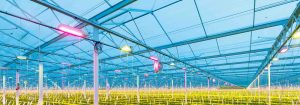Both ‘initial’ and ‘over-time’ performance data have to be evaluated in order to have confidence in how LED grow lights will perform throughout their lifetime. Initial performance can be measured, but it is important to be aware that over-time performance is a prediction based on extrapolated data. The lifetime of an LED grow light is always related to photon flux depreciation, but the technical design choices also make a tremendous difference in how it performs over its lifetime. For more information on this topic, read our blog on how to evaluate the credibility of LED grow light performance claims.
Some manufacturers give specifications for an individual LED lamp instead of a complete LED grow light. We always provide specifications for the complete LED module, called Wall Plug Efficacy (WPE), because how it is designed and manages heat, determines your actual light output and lifetime. An individual LED lamp, for example, might give off 4 µmol/J on its own, but when it is placed in a lighting module, the light output of the entire module could be 3.6 µmol/J. To optimise heat management in the design of our lighting modules, we place thermally conductive paste between the LED and the aluminium heat sink. This guarantees that the module will provide consistent performance over its lifetime.
To make sure that you are reading a specification for the entire LED module, you should look for information about the method used to measure the LED fixture. To ensure standardised specifications, we always measure our LED modules in an official certified laboratory according to the LM-79-80 standards for luminaires. When comparing LED grow light products, you should always ask for the official report provided by the official certified measurement laboratories to ensure that you are comparing the specifications correctly.




